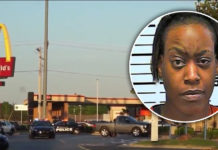
McDonald’s is spending over $1 billion to revamp their 14,000 U.S. restaurants by the year 2015 in an effort to make them look more “grown-up.” You know, like Starbucks and Apple.
Goodbye, fiberglass tables and industrial steel chairs. Adios, neon-yellow, bright-red interiors. Hello, wooden tables, comfortable faux leather chairs and interiors newly painted in muted oranges, yellows and even subtle greens.
Take away all the McDonald’s signage — and the familiar front counter area — and customers who were to drive by or step inside wouldn’t likely know they were face-to-face with a McDonald’s. Even from the street, many of the changes are immediately apparent. No more clown-red roofs. No more confusion about what door to use. And that all-too-familiar white facade has been replaced with more inviting earth tones and glass.
Before any other media have eyeballed the changes — even before select restaurant industry analysts get a sneak peek later this week — USA TODAY was given a look at the McDonald’s remodeling plans in Tampa that will set the tone for the rest of the nation. After revamping 280 stores in various markets last year, McDonald’s is now opting for the Tampa model and will spread that design to upwards of 800 locations this year — roughly triple what it did last year.
“McDonald’s has to change with the times,” says Jim Carras, senior vice president of domestic restaurant development for the giant chain. “And we have to do so faster than we ever have before.”
McDonald’s isn’t just doing this to make customers cozy. It’s doing it to try to quash its rivals — particularly Burger King and Wendy’s — that don’t have McDonald’s deep pockets and the recent sales success necessary to make such costly upgrades. It’s doing it to try to pry customers away from slightly pricier casual chains, including Panera Bread and even Chipotle, the Mexican chain that had once been partly owned by McDonald’s. And it’s doing it to begin cementing a new image of McDonald’s in the minds of consumers.
If the new look proves to be a hit, it could redefine America’s biggest restaurant chain and nudge competitors at all ends of the spectrum to find some way to respond. If consumers don’t buy in, however, it could become McDonald’s $1 billion folly.
With this change, McDonald’s risks looking so different from the McDonald’s most Americans have grown up with that a key part of its customer base — namely, families with young kids — could feel less welcome. “Flashy decor may not sit well with Middle America,” warns Scott Hume, editor of the restaurant industry blog BurgerBusiness. “The trick is to go techno without going Jetsons.”
If the change works, “This could be a game-changer for McDonald’s,” says David Palmer, analyst at UBS. McDonald’s McCafes already have borrowed the wildly profitable specialty coffee concept from Starbucks. Now, it’s also borrowing small pieces of Starbucks’ look and feel. Starbucks executives declined to comment on the changes.
McDonald’s — which for years has emphasized serving customers quickly then getting them out the door — will continue expanding its food and beverage menu, with plans to add even more upscale munchies. The chain no longer wants to rush you in and out. Now it wants you to stick around and tap into free Wi-Fi service as you sip a cappuccino or smoothie while having a Snack Wrap.
To do so, McDonald’s plans to spruce up its outlets like never before. Some are being remodeled. Others are being rebuilt from the ground up.
In addition to Tampa, McDonald’s is renovating stores in the New York City market, where the new designs — particularly the photos and paintings inside — are flashier than in Tampa. However, the changes in the Tampa market more closely reflect what the rest of the nation can expect to see in its local McDonald’s restaurants.
The biggest driver behind the redo: Nicer-looking stores attract more business. Even a smash-hit new product fails to attract as much business as a redesign, Hume says. The handful of Tampa-area stores that franchisee Blake Casper already has redesigned over the past year have seen double-digit sales boosts, he says.
“We want people to say that it feels like a modern building,” says Max Carmona, senior director of U.S. restaurant design.
Perhaps more than anything, the domestic modernization of McDonald’s is about simplicity. Some designs were borrowed from McDonald’s already ultramodernized outlets in Europe and Australia. Some ideas came from slightly more upscale competitors. Some even came from Apple.“We’re not trying to be Apple,” he says. “But we can be inspired by them. When you’re inside an Apple Store, you almost feel like you’re inside an iPad — and you want to stay there. We want people to walk into McDonald’s and have the same feeling.”
Laughable? Perhaps. But the industry is taking it very seriously. “McDonald’s will have a much better chance of luring the most profitable customer (who orders pricey Angus Burgers instead of Big Macs) while retaining the entry-level visitor,” UBS’ Palmer says.
Some McRemodel highlights:
* Redoing roofs. The bright red roofs that have topped McDonald’s for several decades are getting the heave, replaced with flatter, more conventional roofs.* Muting paint. The neon yellows and reds common to the interiors and exteriors are becoming history, replaced with much more subtle oranges, reds, yellows and even greens.
* Nixing fiberglass. The familiar fiberglass tables that have been a mainstay are being replaced mostly by wood.
* Updating chairs. Those industrial steel chairs are giving way to wooden chairs, colorful stools and, in some cases, vinyl-covered chairs that resemble leather. Some stores will have larger lounge chairs similar to the kind you might expect to find in a coffee shop.
* Doubling drive-throughs. To ease lines inside and outside stores, many locations are adding second drive-through windows to speed up service.
* Splashing color. McDonald’s hasn’t junked it’s familiar red and yellow colors altogether, but it is making them far less obvious. Instead of filling the restaurants with them, it’s splashing bright yellow and red here and there for effect.
* Junking the fluorescent look. Overhead fluorescent lights are being replaced with more contemporary lamps that make the lighting in stores look less like that of offices.
* Dividing dining areas. The sea of tables and chairs is history in the remodeled stores. The new dining rooms are divided into separate eating zones for larger groups, eat-and-run customers and folks who want to stay and lounge.
* Adding flat-screens TVs. Large, flat-screen TVs — some playing contemporary music — are showing up in many locations, though fewer than half of the remodeled stores will display them.
* Erecting semi-swooshes. Curving across the top of the newly flattened roof is what McDonald’s calls the yellow “brow” — or half of a golden arch. It’s got the familiar, bright-yellow design but encased in a Nike swoosh-like arc.
The overall redesign “allows us to broaden our menu,” Carras says. Now, “Customer experience can match menu variety.”
One such customer is Melissa Arnold, who recently was using Skype on her laptop while inside a Tampa-area McDonald’s rebuilt from the ground up about six months ago.Arnold, a mother of three teens, is a big fan of the redesign. Last year, she and her kids visited the old store only two times. Since the redesign, she says, they’ve visited at least five times — and she stopped in on her own twice one recent week.
“It makes you feel more comfortable,” she says while sitting in a muted orange, modernized booth, which also gives her some privacy. “It makes you feel like you’re at home.” And that matters. “The environment is a massive influence on how we behave,” says brand guru Philip Graves. “Change the environment, and you change how people perceive everything else.” Even little people.
While visiting McDonald’s with her mom — and three girlfriends — 10-year-old MacKenzie Crouse of Valrico, Fla., sips a soft drink, looks around the newly designed McDonald’s and says the restaurant no longer looks like it’s for babies. “It’s for everybody.”
Her mom, Melanie, who also is a nurse, says she, too, likes the redesign but hopes it signals a redesign of something else at McDonald’s: the food. “I’m hoping,” she says, while watching her crew of preteens down a tray-load of burgers, fries and soft drinks, “this means McDonald’s will also be bringing in more fresh fruits.”
Oh okay, we get it now. Apple makes their customers feel like they’re inside of an iPad. So does McDonald’s want us to feel like we’re inside of a Big Mac or something?
Regardless of how “fresh” they make their buildings look, at the end of the day, it’s about the food being served. And no one in their right mind is going to pick going to McDonald’s over going to Panera Bread or Chipotle or Starbucks.
























